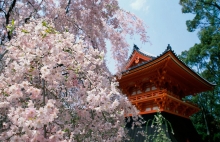- Christmas Holiday
- Eight Activities That Will Definitely Raise Your Heart Rate
- Five Undiscovered Beach Destinations In The World
- Top 10 Most Famous Beaches In The World
- Eight Exotic But Inexpensive Holidays
- Ten Experiences Guaranteed to Give You The Shivers
- Six Ephemeral Masterworks of Nature
- Eight Things To Hear Before You Die
- Seven Places Where Time Seems to Stand Still
- Eight Trips Where The Journey Is The Destination
- The Best Ethnic Neighborhoods in the USA
- Eight Places To Find The Most Beautiful Females In The World
- Seven Tasty Reasons To Over in Dulge
- Seven Places That Awaken Your Inner Child
- Eight Over The Top Celebrations You'll Never Forget
- Eight Places Where Rock Is The Star
Six Ephemeral Masterworks of Nature
1. Cherry blossoms, Yoshino Mountain, Japan
Every April, after the bleak winter skies clear, gentle spring breezes carry pink and white petals that flutter to the ground like snowflakes. Connoisseurs head for Yoshino Mountain, which is covered in thousands of white mountain cherry trees dating back to the days of the samurai-and whose delicate blossoms last only a couple of weeks.
2. Lunar rainbows, Victoria Falls, Zimbabwe.
The falls are every bit as monumental and magnificent as you imagined-a mile wide, crashing down 400 feet, making a noise greater than a million migrating wildebeests. But he mist creates more delicate visuals-rainbows in the day, and at night, if the moon is bright and full enough, lunar rainbows that drift in and out of view.
3. The coral spawn at Heron Island, Australia.
Unlike many islands of the Great Barrier Reef, Heron is a coral cay-actually part of the reef itself. Each November, when the coral spawns, the polyps disgorge billions of pink and purple eggs and sperm. For divers, who come from every corner of the globe, it's like being inside of a rosy snowstorm.
4. Disappearing glaciers, Glacier National Park, Montana.
The glaciers that formed this norrthern most part of the American Rockies, carving out the awe-inspiring landscape, have done their work over the past several millennia. But their days are numbered. A little more than a century ago there were 150 named glaciers in the park; today they are only 37. At this rate, the glaciers will all but disappear by 2030. Visit the park soon while you can still marvel at these vanishing beauties.
5. Monarch butterfly migration, Michoaean, Mexico.
Every autumn, like clockwork, millions of orange-and-black-winged monarch butterflies migrate from the eastern United States and Canada and arrive, as if from out of nowhere, to alight on the green fir trees, northwest of Mexico City. They are so numerous that when they fly, the sky appears filled with orange and yellow confetti and you can hear their wings beating-and the combined weight of their tiny bodies can actually break the limbs off the trees.
6. The Northern Lights, Manitoba, Canada.
During clear winter nights, arctic winds collide with the electron-charged atmosphere of the earth, creating eerily massive and silent aurora borealis, shimmering across the sky in spectacular colors.


